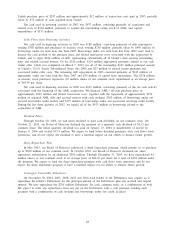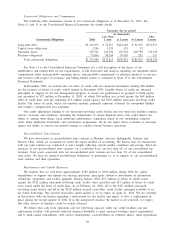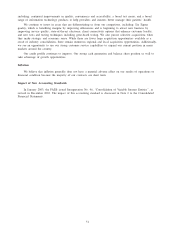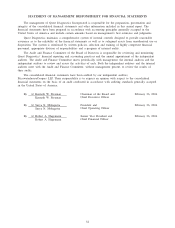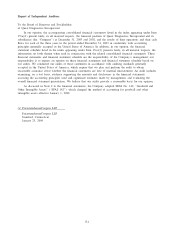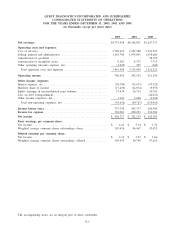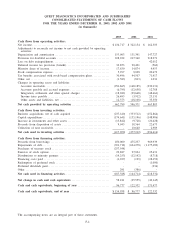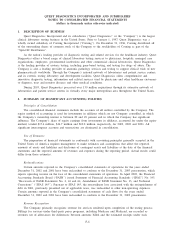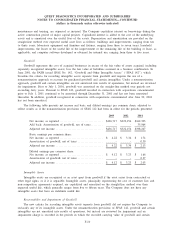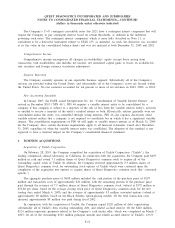Quest Diagnostics 2003 Annual Report Download - page 75
Download and view the complete annual report
Please find page 75 of the 2003 Quest Diagnostics annual report below. You can navigate through the pages in the report by either clicking on the pages listed below, or by using the keyword search tool below to find specific information within the annual report.QUEST DIAGNOSTICS INCORPORATED AND SUBSIDIARIES
NOTES TO CONSOLIDATED FINANCIAL STATEMENTS
(dollars in thousands unless otherwise indicated)
1. DESCRIPTION OF BUSINESS
Quest Diagnostics Incorporated and its subsidiaries (“Quest Diagnostics’’ or the “Company’’) is the largest
clinical laboratory testing business in the United States. Prior to January 1, 1997, Quest Diagnostics was a
wholly owned subsidiary of Corning Incorporated (“Corning’’). On December 31, 1996, Corning distributed all
of the outstanding shares of common stock of the Company to the stockholders of Corning as part of the
“Spin-Off Distribution’’.
As the nation’s leading provider of diagnostic testing and related services for the healthcare industry, Quest
Diagnostics offers a broad range of clinical laboratory testing services to physicians, hospitals, managed care
organizations, employers, governmental institutions and other commercial clinical laboratories. Quest Diagnostics
is the leading provider of esoteric testing, including gene-based testing, and testing for drugs of abuse. The
Company is also a leading provider of anatomic pathology services and testing to support clinical trials of new
pharmaceuticals worldwide. Through the Company’s national network of laboratories and patient service centers,
and its esoteric testing laboratory and development facilities, Quest Diagnostics offers comprehensive and
innovative diagnostic testing, information and related services used by physicians and other healthcare customers
to diagnose, treat and monitor diseases and other medical conditions.
During 2003, Quest Diagnostics processed over 130 million requisitions through its extensive network of
laboratories and patient service centers in virtually every major metropolitan area throughout the United States.
2. SUMMARY OF SIGNIFICANT ACCOUNTING POLICIES
Principles of Consolidation
The consolidated financial statements include the accounts of all entities controlled by the Company. The
equity method of accounting is used for investments in affiliates which are not Company controlled, in which
the Company’s ownership interest is between 20 and 49 percent and in which the Company has significant
influence. The Company’s share of equity earnings from investments in affiliates, accounted for under the equity
method, totaled $17.4 million, $16.7 million and $10.8 million, respectively, for 2003, 2002 and 2001. All
significant intercompany accounts and transactions are eliminated in consolidation.
Use of Estimates
The preparation of financial statements in conformity with accounting principles generally accepted in the
United States of America requires management to make estimates and assumptions that affect the reported
amounts of assets and liabilities and disclosure of contingent assets and liabilities at the date of the financial
statements and the reported amounts of revenues and expenses during the reporting period. Actual results could
differ from those estimates.
Reclassifications
Certain amounts reported in the Company’s consolidated statements of operations for the years ended
December 31, 2002 and 2001 have been reclassified to conform to the December 31, 2003 presentation, which
reports operating income on the face of the consolidated statements of operations. In April 2002, the Financial
Accounting Standards Board (“FASB’’) issued Statement of Financial Accounting Standards (“SFAS’’) No. 145,
“Rescission of FASB Statements No. 4, 44 and 64, Amendment of FASB Statement No. 13, and Technical
Corrections’’ (“SFAS 145’’). Pursuant to SFAS 145, the extraordinary loss associated with the extinguishment of
debt in 2001, previously presented net of applicable taxes, was reclassified to other non-operating expenses.
Certain amounts reported in the Company’s consolidated statements of cash flows for the years ended
December 31, 2002 and 2001 have been reclassified to conform to the December 31, 2003 presentation.
Revenue Recognition
The Company primarily recognizes revenue for services rendered upon completion of the testing process.
Billings for services under third-party payer programs, including Medicare and Medicaid, are recorded as
revenues net of allowances for differences between amounts billed and the estimated receipts under such
F-6


